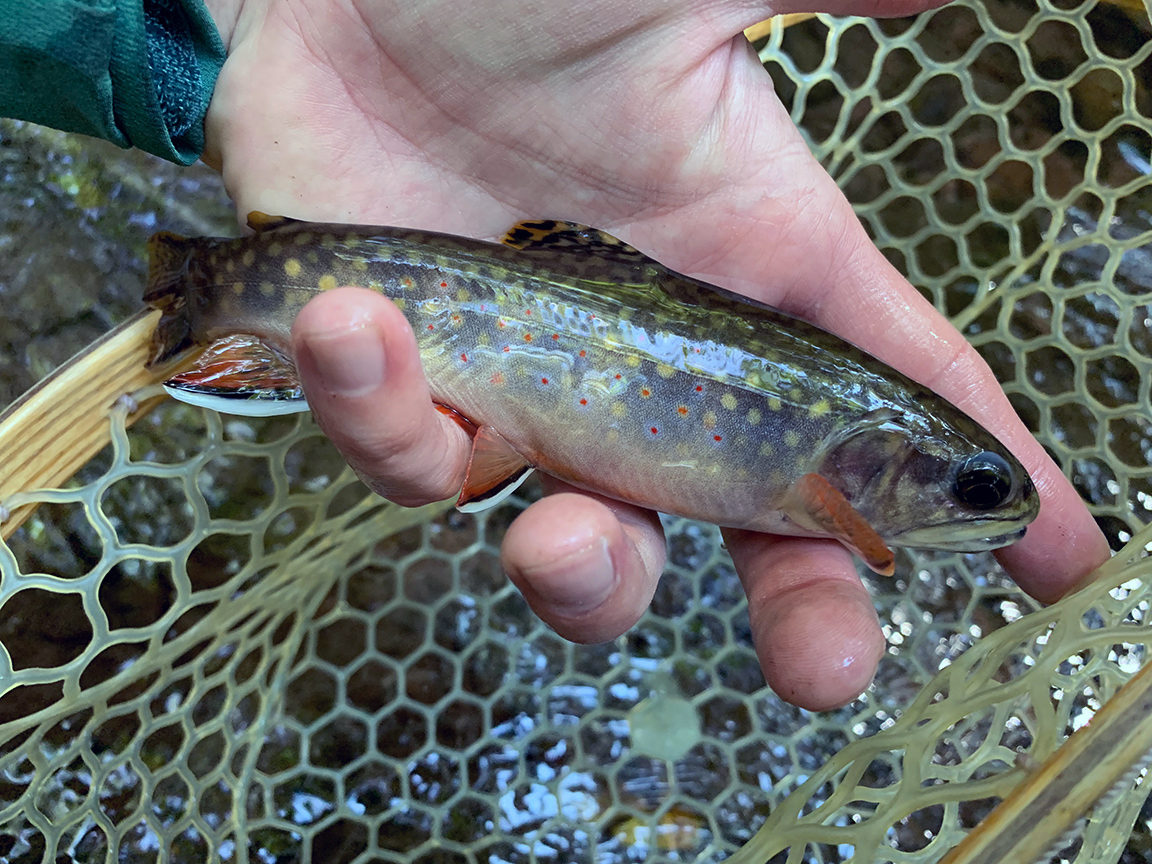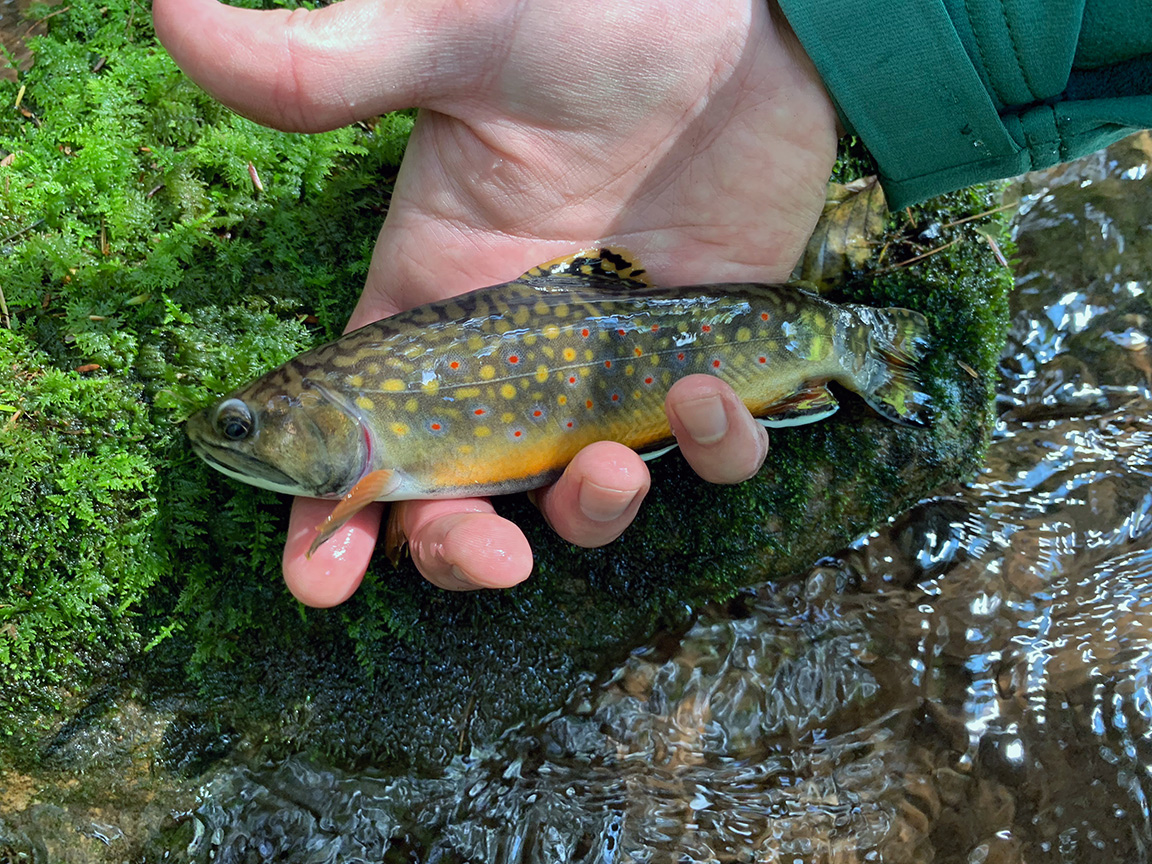Each year during the months of September and October, Pennsylvania’s wild brook trout begin spawning. The start of the spawn is different in every stream and is typically touched off by a change in water temperature. During the spawn, the male brook trout begin to change color. The orange on their fins and bellies becomes vibrant as they prepare to join females on redds. There is a lot of controversy around whether or not it is ethical to fish for brook trout while they are spawning. Some folks feel that fishing has little to no impact, as long as careful catch and release is practiced. Others believe that it is the worst thing a fisherman could take part in and avoid fishing entirely.
Personally, I prefer not fishing for wild Pennsylvania brook trout during the months of October and November. The spawn allows this incredible resource to continue and I’d rather allow the fish to do what they’ve been designed to do. I will head out seeking brook trout again during the solace of winter, when the woods are quiet and the fish won’t pass up an opportunity for an easy meal.
On Sunday I decided to head to Snyder County, Pennsylvania to fly fish a stream in Bald Eagle State Forest. I’d researched this stream for a couple of weeks. This Pennsylvania Class A water known as Moyers Mill Run was defined as only being 60% public access. The headwaters, which fall within the state forestland, did not appear to have any trail access. I knew when I went in it was going to be an intense outing and would require a lot of hiking and unexpected challenges. My girlfriend Jen had expressed interest in joining me so she could see what this brook trout thing was all about and she couldn’t have picked a better trip to learn.
Jen and I headed out of Lancaster County at 5:30AM. We took the familiar road toward State College, Rt. 322, and then exited onto Rt. 333 at Thompsontown. We headed north towards the southern most fingers of the Bald Eagle State Forest. Penns Creek often overshadows many less well-known streams in this part of the state. I can assure you, Penns Creek is not the only great water in Snyder, Union, Centre, and Mifflin Counties. I’d pinpointed a state forest road off of Rt. 235 and once we arrived, I threw the truck into four-wheel drive and we headed into the woods. I used Google Maps to locate a good place to enter on foot. Once we were parked and I was beginning to get my gear out, I realized I’d forgotten to change out the reels in my reel case from my recent trip to Pulaski for salmon. I was frustrated but I thrive on problem solving. I knew one of my salmon reels had a floating line on it so I decided to use it, even thought it was an 8wt rated line on an 8wt rated reel going on a 4wt rated G-Loomis fly rod. Brook trout fishing on small streams often only takes place on the leader and so I figured I could survive the day with an imperfect set-up.
Jen and I packed an extra bottle of water and headed down the steep hillside and into the woods. After hiking a hundred yards we stopped and could hear water running. I guessed this was the headwater we were looking for and we headed in the direction of the sound. Eventually we came across an area where the forest floor was very rocky and natural springs were bubbling up from the earth below. As we continued, the amount of water increased until there was a small stream flowing down through the hollow. Eventually the stream cut deeper into the hillside and Jen and I were climbing over large rocks and navigating through and around a number of fallen trees. The hillsides became steep and soon we were descending down a fairly steep rock face. All I could think about was running into a rattlesnake, which has yet to happen this year. Jen has a fear of snakes, so I was hoping this wouldn’t be the day my fortunes changed. Although the water felt cold enough to hold trout, it looked like the most difficult brook trout stream I’d encountered in all my adventures to date. I was seriously concerned about finding any opportunities to catch fish. After 45 minutes of intense hiking, the rush of water was much louder. I looked ahead and to my surprise, a much larger stream lie ahead. It turned out this stream was Moyers Mill Run and the stream we’d walked in on was a small tributary. The body of water we’d come to had a good width and depth and looked like it would hold fish.
While standing next to Moyers Mill Run, Jen noticed that there was a foot trail that followed the left bank. Because we were at the top of the public access, we decided to follow the foot trail as far as we could so that we could fly fish upstream and not alert the fish to our presence. Using Google Maps, we were able to follow the stream to the point where the public access ended. Once there we moved into the water and began working our way upstream, looking for prime fish lies. I decided to use a hopper/dropper set-up, which was comprised of a large red and black foam grasshopper imitation with rubber legs. Off of the hook bend I tied a nymph Frankie Schoenfelt created called the Priceless Nymph. This pattern looks like a Hare’s Ear Nymph tied on a nymph hook with a pink bead head and a red collar and tail. I used 5X tippet tied off of a 7.5X leader.
When fishing close to the start of spawning season, it is a good idea to do a visual search of shallow gravel covered areas in tailouts below pools. These areas are prime for spawning brook trout and if you see them, you can decide to not fish, or to stay out of the water and focus on the pools themselves. We did not observe any brook trout on redds or any fish displaying spawning behavior in the first several good runs we moved through. We stayed close to the bank to be safe. Eventually we came across a run that moved next to a large boulder with a prime lie and sure enough, on my second cast, a good-sized Pennsylvania wild brook trout rose and took the hopper pattern. After landing him, Jen and I were amazed by the brilliance of the colors on the fish.
The first brook trout I caught displaying brilliant pre-spawn colors.
There is no mistaking a male pre-spawn brook trout. We continued upstream and worked every area that looked like it would hold fish. I was surprised at the number of areas that looked fishy but no explosion came to the surface. There were many misses. I watched numerous attempts by smaller brook trout to take the large hopper, fail, come back, make another attempt and miss the hook. The upside of fishing a large hopper as an indicator is that only the larger fish will find the hook. The downside is that you will not catch as many fish. On several occasions I caught some very small wild brook trout, indicating that this stream has an excellent population. Certainly the water temperatures were adequate as my thermometer read 55 degrees by 10AM.
It is amazing how fast time passes when you are brook trout fishing far from a road, city, or any other indicator of civilization. After we’d caught 8 solid trout, Jen looked at her phone and said it was 1:00PM. We continued working our way upstream and eventually made our way back to our original entry point. However, we found that this was not close to the springs that made the headwaters. We continued hiking and fishing, catching several large wild male brook trout that displayed pre-spawn colors and the appearance of a hooked jaw. There were less colorful female brook trout mixed in as well.
After we passed the larger tributary we’d walked in on, the stream began to narrow. Eventually Moyers Mill Run became nothing more than spring water gurgling out of rocks in the ground. I looked at Jen and while she was doing her best to let me know she could keep up, I could tell she was as exhausted as I was. I decided I’d caught enough wild brook trout for one day and decided to wrap things up. I used the GPS on my phone to pinpoint where Jen and I’d hiked. We had to backtrack a couple hundred yards until I found a hollow that we could hike up and out to the state forest road.
The bottom of the hollow was so littered with fallen trees that it became virtually impassible. I stopped and looked up the steep hillside and then looked at Jen. I asked her if she thought she could make it and she said yes. We spent 30 minutes hiking up the steep hillside. We had to stop ever five minutes to rest against trees and avoid slipping back down the route we’d come. Eventually we crested the top and our tired legs stumbled over thick underbrush as the welcome site of the state forest gravel road could be see through the gaps in the tree. We made it out to the road and I gave Jen a high five. We drank a bottle of water and then made the long walk back to the truck in the late afternoon daylight.






